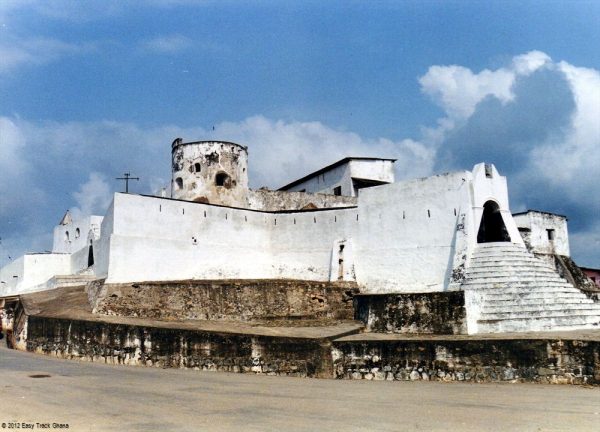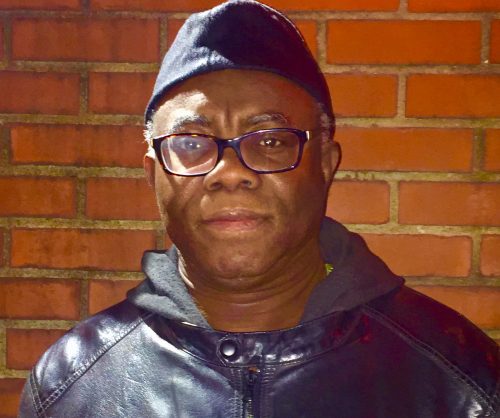 It has taken me almost 60 years to learn some of the most horrific and shocking details of the local side of the massive enslavement of Africans between the Fifteenth and Nineteenth centuries. At Elmina, I was painfully and wistfully confronted with the majestically marked grave of a European slave-trading governor who had died of a disease, perhaps cholera, shortly after his arrival. This dehumanizer of Africans is described on a plaque on a wall above his tomb as a “Righteous, Good and Upright Man.” Irony of ironies. At first, I thought it was the grave of the legendary Don Diego De Azambuja (or D’Azambuja), the first Governor and architect of the castle. But my attempts to Google-confirm this turned up naught or zilch, as New Yorkers are wont to say. It looks as if D’Azambuja had returned peacefully home to Portugal and died there as an old man. My interest in this aspect of the narrative by Mr. Kugbe, the Tourist Guide, was inspired by my recent reading about a couple of allegedly enslaved Africans in the diaspora whose remains were reportedly returned from the United States to be reinterred at Assin Manso.
It has taken me almost 60 years to learn some of the most horrific and shocking details of the local side of the massive enslavement of Africans between the Fifteenth and Nineteenth centuries. At Elmina, I was painfully and wistfully confronted with the majestically marked grave of a European slave-trading governor who had died of a disease, perhaps cholera, shortly after his arrival. This dehumanizer of Africans is described on a plaque on a wall above his tomb as a “Righteous, Good and Upright Man.” Irony of ironies. At first, I thought it was the grave of the legendary Don Diego De Azambuja (or D’Azambuja), the first Governor and architect of the castle. But my attempts to Google-confirm this turned up naught or zilch, as New Yorkers are wont to say. It looks as if D’Azambuja had returned peacefully home to Portugal and died there as an old man. My interest in this aspect of the narrative by Mr. Kugbe, the Tourist Guide, was inspired by my recent reading about a couple of allegedly enslaved Africans in the diaspora whose remains were reportedly returned from the United States to be reinterred at Assin Manso.
At the Cape Coast Castle, however, I was elated to see the equally well-marked and majestic tomb of the legendary Rev. Philip Quacoe (Kweku) – (Circa. 1740-1816) – the first precolonial British-educated Ghanaian and African to be ordained an Anglican Priest by the Society for the Propagation of the Gospel. Rev. Quacoe was also known as a great educator who schooled a remarkable number of mulatto children of both genders, first in his own home and later at the so-called Castle Schools in Cape Coast. He would also take on the education of indigenous African children. Alongside the grave of the Rev. Philip Quacoe, was those of Capt. George MacClean, the putative founder of colonial Gold Coast, and his star-crossed wife, Letitia Elizabeth Landon, believed to have either committed suicide as a result of being brokenhearted by her husband’s marital infidelity, or to have been poisoned by her husband’s mistress, whose name I cannot readily recall because I had not come along with my notepad. I wanted to enjoy the entire tour in the apocalyptic past without any distractions whatsoever. All three tombs are marked with the initials of the names of their human contents.

But what I really want to especially observe here is the narratological motif of “Assin-Manso” that kept appearing in the narratives of both Tourist Guides at Elmina and Cape Coast, namely, Messrs. Kugbe and Essel, respectively, as the geographical location that marked the last stop on the land journey of the African captives bound for chattel slavery in the Americas or the New World prior to being jampacked into the dungeons at Cape Coast and Elmina. We were informed that it was at Assin-Manso that these captive-victims of the Transatlantic Slave Trade, euphemistically dubbed “The Middle-Passage,” were given their last baths before they were taken into the dungeons and through the tunnel nicknamed the point or Door of No Return. At Cape Coast, and I believe at Elmina too, the inscriptions above these doors have been relabeled as “The Door of Return.” I am quite certain that the lurid processing of the Africans bound for enslavement in the Americas was almost wholly done by their Ghanaian captors or buyers or their assigns. But in their narratives, my two Tourist Guides did not even glancingly hint at this fact. Perhaps this was obviously because of the discomfort that such grim knowledge would induce in our visiting brothers and sisters from the African Diaspora, some of who had left wreaths in the dungeons in memory of the excruciating pain and suffering of their ancestors.
At Cape Coast, in one of the dungeons, we were shown a modernized shrine that the European overlords of the castle had permitted the African captives to erect for their own spiritual and/or psychological sublimation, perhaps in a strategic bid to, somewhat, easing up the acute mental anguish that came with the desperate and stark realization of the fact that they could do absolutely nothing to reverse their impending fate or certain doom. Here, I took a little issue with Mr. Essel, our Tourist Guide, because he had either out of discomfort or total ignorance, or even feigned or strategic ignorance, failed to highlight the fact that the two bottles of German- or Dutch-distilled Schnapps that sat on the pedestal representing the shrine were actually ritual symbols that were later incorporated into the African religious rituals as veritable items of trade or legal tender that had been used in the purchase of Africans marked down for brutal enslavement by Western Europeans in the Americas and the Caribbean Islands. It was also at this juncture that I began to wonder whether it would not make better sense for either the Ghana Tourism Board (GTB) or the Ministry of Tourism (and Culture) to think of recruiting graduates of Ghanaian and African History from the University of Ghana, and the other major universities and colleges in the country, to handle this aspect of the operations of these World Historical Sites and Monuments.
Hospitality Management specialists like Messrs. Kugbe and Essel could then focus on the management of such aspects of the Tourism Industry as Hotel and Restaurant Management. They could also be more profitably reassigned to work in/or manage the Gift Shops. Then also, it would be even more instructive or meaningful if prior to being conducted around the premises of these historical sites, tourists could be gathered in an auditorium and shown a filmic documentary overview of the various compartments of these forts and castles. Perhaps a documentary lasting anywhere from 30 minutes to an hour, instead of being unceremoniously ushered into the rather much too small old chapel converted into an insufferably too-busy billboards gallery saturated with the photographs of historical figures – both Ghanaian and European – arranged in no apparent order, with no guides to explain, narrate and facilitate any instructive interpretations of the same. Or maybe, we simply happened to be visiting these castles during their peak hours when they were too many tourists and visitors to manage.
*Visit my blog at: kwameokoampaahoofe.wordpress.com Ghanaffairs
The views expressed by this author remain solely their own and are not to be taken as the view of the Editorial Board of www.africanewsanalysis.com, www.zongonews.com and ZongoNews Radio & TV
